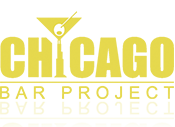“Chicago’s Oldest South Loop-Printers Row Family Owned Bar and Restaurant”
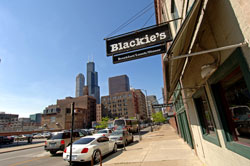 Though it has been in business for over 70 years, has served up some of the city’s best burgers to celebrities like Frank Sinatra, Rock Marciano and Muhammad Ali, the main notoriety of Blackie’s sadly comes from those confusing it with the Chicago burger chain with the Northeastern name, Boston Blackie’s. No matter, knowledge is power and those that know of the real Printers Row classic are the ones that make out for some excellent pub grub, an always satisfying game of Pac-Man, and a link to Chicago’s colorful past.
Though it has been in business for over 70 years, has served up some of the city’s best burgers to celebrities like Frank Sinatra, Rock Marciano and Muhammad Ali, the main notoriety of Blackie’s sadly comes from those confusing it with the Chicago burger chain with the Northeastern name, Boston Blackie’s. No matter, knowledge is power and those that know of the real Printers Row classic are the ones that make out for some excellent pub grub, an always satisfying game of Pac-Man, and a link to Chicago’s colorful past.
 Blackie’s is located at the northeast corner of Clark & Polk Streets, the latter of which was named after an American president who is almost as well-known as Blackie’s is to locals outside of the neighborhood. The annual Printers Row Lit Fest (book fair) in June begins at Dearborn and Congress, runs to Polk Street, takes a right turn, and ends here at Clark. With its sidewalk café, Blackie’s is your best bet for a seat during the Lit Fest as Kasey’s (drinks only) and Hackney’s on Dearborn both get mobbed, especially if it rains (which it seems to every year). Indoor parking for as cheap as five dollars for a few hours is available across the street with validation provided by Blackie’s.
Blackie’s is located at the northeast corner of Clark & Polk Streets, the latter of which was named after an American president who is almost as well-known as Blackie’s is to locals outside of the neighborhood. The annual Printers Row Lit Fest (book fair) in June begins at Dearborn and Congress, runs to Polk Street, takes a right turn, and ends here at Clark. With its sidewalk café, Blackie’s is your best bet for a seat during the Lit Fest as Kasey’s (drinks only) and Hackney’s on Dearborn both get mobbed, especially if it rains (which it seems to every year). Indoor parking for as cheap as five dollars for a few hours is available across the street with validation provided by Blackie’s.
The gray building housing Blackie’s is fairly plain with its gray brick, minimalist black awnings, American flags, and humble Blackie’s sign in white lettering upon a black background. If you look closely, you may notice that the third floor looks a bit different. It turns out that this level burned at one point when the pub featured Italian dining on the rooms above and has since been replaced by cinder blocks that almost exactly match the color of the first two floors. Today, Blackie’s consists primarily of the ground floor, accessible through a simple plate-glass door.
 Once inside Blackie’s, you’ll find a wooden bar that runs half the length of the room’s northern wall. The bar serves a fairly standard selection of about eight beers on tap and 40 in bottles, the latter of which are displayed above the bar, each in a painted ceramic hand… In addition to a few televisions placed throughout the room, entertainment at Blackie’s is available from the Pac-Man and Golden Tee machines across from the bar, in the middle of which is a CD jukebox.
Once inside Blackie’s, you’ll find a wooden bar that runs half the length of the room’s northern wall. The bar serves a fairly standard selection of about eight beers on tap and 40 in bottles, the latter of which are displayed above the bar, each in a painted ceramic hand… In addition to a few televisions placed throughout the room, entertainment at Blackie’s is available from the Pac-Man and Golden Tee machines across from the bar, in the middle of which is a CD jukebox.
Grab a high-backed wooden barstool up front or there is also waitress service at a few cocktail tables and more low-slung wooden tables with ice cream parlor chairs in back. For an artistic touch, Blackie’s features paintings, photos and stained glass created by neighborhood artists. Rounding out the décor is a brown linoleum floor with speckles, exposed brick walls, a large bust of a Roman goddess set high upon a shelf above the side door, and—at least on my last visit—numerous paper baseballs hang from a high wood-slatted ceiling. The one-seater restrooms are found just past the bar and in the middle of the northern wall. As added entertainment, the mensroom features a lovely poster of a woman playing tennis lifting up her skirt and exposing her bum above the pot.
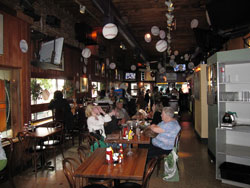 Even though a sign above the door on your way out reads, “Slightly Better than Hospital Food,” this is clearly tongue-in-cheek because the the story at Blackie’s is the burgers. Instead of the frozen, pre-formed patties that most other establishments claiming to serve the “best burger” in Chicago, Blackie’s offers juicy handmade patties on a tasty bun, seasoned curly fries (a little too fried for our liking) with thick sliced pickles à la Billy Goat Tavern. Even the mini-burgers are “certified” Black Angus and, while places like Monk’s Pub seemingly offer an endless variety of burgers, Blackie’s keeps it simple with all the main toppings you could want but nothing fancy. The rest of the menu features a few other sandwiches, entrées, much beloved onion rings, and delectable chili that has some kick to it. Blackie’s serves lunch and dinner, as well as breakfast on Friday (7:30-10:30am) and brunch on the weekends (7:30am-1:30pm). According to a waitress, everything on the menu is made from ingredients purchased by the same local vendors Blackie’s has been doing business with for many years.
Even though a sign above the door on your way out reads, “Slightly Better than Hospital Food,” this is clearly tongue-in-cheek because the the story at Blackie’s is the burgers. Instead of the frozen, pre-formed patties that most other establishments claiming to serve the “best burger” in Chicago, Blackie’s offers juicy handmade patties on a tasty bun, seasoned curly fries (a little too fried for our liking) with thick sliced pickles à la Billy Goat Tavern. Even the mini-burgers are “certified” Black Angus and, while places like Monk’s Pub seemingly offer an endless variety of burgers, Blackie’s keeps it simple with all the main toppings you could want but nothing fancy. The rest of the menu features a few other sandwiches, entrées, much beloved onion rings, and delectable chili that has some kick to it. Blackie’s serves lunch and dinner, as well as breakfast on Friday (7:30-10:30am) and brunch on the weekends (7:30am-1:30pm). According to a waitress, everything on the menu is made from ingredients purchased by the same local vendors Blackie’s has been doing business with for many years.
 An Art Deco-painted door in the northeast corner of the room leads to the party room that is larger than the main room and accommodates 50-150 people. Once a long-vacant space, this room features an original Brunswick bar of walnut and mahogany (installed as part of the remodeling), vaulted ceiling and a staircase that leads to The Normandie Room (aka: The Speakeasy) in the basement, modeled after the S.S. Normandie Smoker’s Lounge. While Blackie’s has always been a bar, and possibly a speakeasy through prohibition, the adjacent building likely was not.
An Art Deco-painted door in the northeast corner of the room leads to the party room that is larger than the main room and accommodates 50-150 people. Once a long-vacant space, this room features an original Brunswick bar of walnut and mahogany (installed as part of the remodeling), vaulted ceiling and a staircase that leads to The Normandie Room (aka: The Speakeasy) in the basement, modeled after the S.S. Normandie Smoker’s Lounge. While Blackie’s has always been a bar, and possibly a speakeasy through prohibition, the adjacent building likely was not.
Blackie’s is now in its fifth generation of family ownership. It all began when Alex de Millo opened Blackie’s in 1939, though it wasn’t easy: the previous Irish owners supposedly didn’t want to sell to an Italian so the deal was brokered by an Irish friend of the family. According to Blackie’s, “During the 1940s and 1950s, Alex teamed up with a charming restaurateur, nicknamed Blackie, and together they attracted a clientele ranging from Glen Miller and Tommy Dorsey to the Harlem Globetrotters and Rocky Marciano to the Marx Brothers and the Three Stooges.” Many mid-20th century celebrities would stop by on layovers when connecting in Chicago via nearby Union and Dearborn stations.
 Founder Alex de Millo
Founder Alex de Millo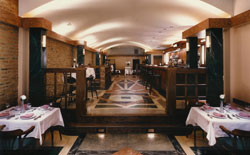 Blackie’s Back Room
Blackie’s Back Room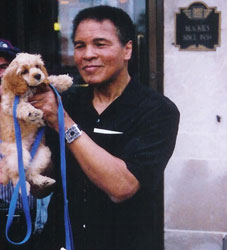 Muhammad Ali at Blackie’s
Muhammad Ali at Blackie’s
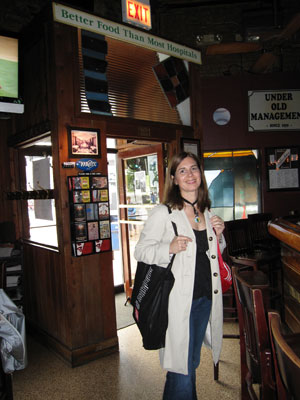 The management goes on to say, “Blackie retired in the mid-1950s. The neighborhood seemed to do the same. With the closing of the Dearborn Train Station, the razing of the St. Peter’s Church, and the relocating of many printing companies, the corner of Polk and Clark became indeed a bare spot. Nonetheless, Alex stayed on and on until the 1970s when his grandson, Jeffery Thomas, became involved and responsible for introducing the rehabbed Blackie’s to Printers Row.” Thomas rehabbed the tavern in the ’90s to give it its current look. Blackie’s also claims to have hosted Mel Gibson and former Speaker of the House Denny Hastert for breakfast. As an added bit of intrigue, it turns out that Alex De Millo allegedly sold equipment to a bookmaking operation and was subpoenaed in 1951 according to a Chicago Tribune article, though it is not clear if the case was ever made…
The management goes on to say, “Blackie retired in the mid-1950s. The neighborhood seemed to do the same. With the closing of the Dearborn Train Station, the razing of the St. Peter’s Church, and the relocating of many printing companies, the corner of Polk and Clark became indeed a bare spot. Nonetheless, Alex stayed on and on until the 1970s when his grandson, Jeffery Thomas, became involved and responsible for introducing the rehabbed Blackie’s to Printers Row.” Thomas rehabbed the tavern in the ’90s to give it its current look. Blackie’s also claims to have hosted Mel Gibson and former Speaker of the House Denny Hastert for breakfast. As an added bit of intrigue, it turns out that Alex De Millo allegedly sold equipment to a bookmaking operation and was subpoenaed in 1951 according to a Chicago Tribune article, though it is not clear if the case was ever made…
So there you have it: a classic Chicago tavern story. A humble beginning, celebrity appeal, perseverance through decades of urban decay, rebirth along with the neighborhood over the last 15 years, and a damned fine burger—even if every other bar guide and most other online outlets don’t give it much love. For more information, check out the Blackie’s website.
“Our commitment to the neighborhood is to provide friendly atmosphere, free of snobbery and excessive prices.”

Blackie’s during Printers Row Lit Fest
